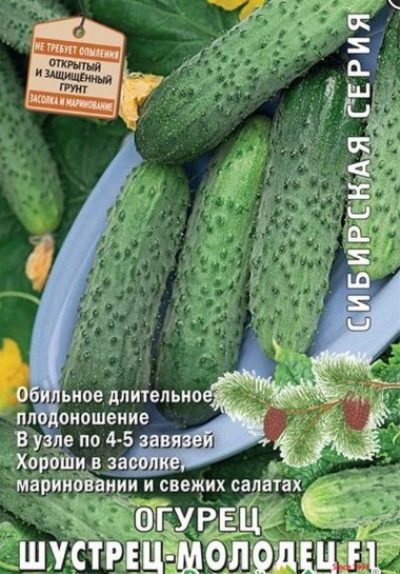
- Authors: S.V. Maximov, N.N. Klimenko, O. V. Baklanov (LLC "Agrofirma Poisk")
- Name synonyms: Ogurets Shustrets-molodets F1
- Year of approval: 2015
- Growth type: vigorous, indeterminate
- Branching: weak
- Fruit weight, g: 120-130
- Fruit length, cm: 11-13
- Fruit color: dark green, with short stripes
- Ripening terms: early
- Fruit shape: cylindrical
Breeders continue to regularly delight gardeners with new, attractive varieties. One of their relatively recent gifts was a hybrid variety of cucumber Shustrets-well, which has already become one of the favorites of many gardeners. We will tell you who it is suitable for, and how to achieve the maximum germination and yield from the variety.
Breeding history
The variety was developed by S. V. Maksimov, O. V. Baklanova and N. N. Klimenko at Agrofirma Poisk LLC. The beginning of the use of the variety is 2015.
Description of the variety
The young fellow is a one-year hybrid of the parthenocarpic type with female inflorescences and a bouquet variant of flowering.
Characteristics of the appearance of plants and zelents
Weakly branched, vigorous hybrid variety. It produces a lot of rather large leaves, up to 5 ovaries per node.
The sizes of zelents are 11-13 cm in length and about 3.5 cm in diameter. Weight - from 120 to 130 grams. Cucumbers are dark green, with lighter areas, lumpy, white-thorn. The shape is cylindrical.
Purpose and taste of fruits
Crispy cucumbers, without bitterness, juicy. Suitable for fresh consumption, in salads, sandwiches, for canning. The keeping quality and transportability are excellent.
Maturation
The cucumber variety Shustrets is one of the early ripening varieties. From the first shoots to the first harvest - 40-45 days. Fruiting until the middle, and sometimes until the end of September.
Yield
In greenhouses, with proper care, an average of 12.5 kg of cucumbers can be harvested from 1 m2.
Growing regions
Suitable for landing in any region, but the most suitable are the following:
northern;
Northwestern;
Central;
Volgo-Vyatsky;
North Caucasian;
Middle Volga;
Nizhnevolzhsky;
Ural;
West Siberian;
East Siberian;
Far Eastern.
Landing scheme
Due to the peculiarities of flowering, planting this crop is required near plants with male inflorescences, or in the place where pollinators are present. The plot must be sunny.
Planting scheme: 65x25 cm Planting depth:
1-2 cm - for seeds;
0.5-1 cm - for seedlings.
Growing and care
The first thing to do in order to get a good harvest from the hybrid variety Shustrets is to properly prepare the seed material.
Disinfect the seeds with a strong solution of potassium permanganate, heated with hydrogen peroxide or a fungicide solution. Dry. Sort the seeds, getting rid of the damaged ones.
Prepare a mixture for seedlings from turf, humus, peat, coarse sand (proportions 1/2/1/1), or use ready-made soil of a proven brand.
Fill the pots 2/3 with the mixture.
Add wood ash, double superphosphate and potash fertilizer to the ground.
Plant the material in a container to a depth of 2 centimeters.
Cover with foil, which will need to be removed when the sowing rises.
Recommended temperature range for seedlings:
from 26 to 28 ° C for the period until germination;
21 ° C during the day and 17 ° C at night after the leaves open.
2 weeks after the emergence of seedlings, you can begin to harden the cucumbers, leaving them on the balcony or by an open window (no draft) for a couple of hours.
The soil in containers with seedlings must remain moist.
You need to feed the seedlings only if there are doubts about the fertility of the soil.
While the "nimblers" are growing up, you can add the rest of the soil to their pots.
Two days before moving to the beds, you need to process the seedlings with an adaptogen.
The cucumber is suitable for both greenhouse and open field cultivation. Seedlings are planted after the threat of frost has passed.
It is recommended to fertilize with mineral fertilizers 3 times. Of other care measures, loosening and timely weeding are required. The average interval between waterings is 5 days at the growth stage and 1-2 days after the formation of ovaries. Water consumption at different stages from 5 to 12 liters per 1 m2. Watering the plant is desirable in the evening.
Soil requirements
The earth must be breathable. Medium and light loamy options are suitable.

In order to collect strong, tasty and beautiful cucumbers on your site, you need to make top dressing. Lack of nutrients can negatively affect the appearance of the plant and significantly reduce the yield. Fertilize cucumbers with organic fertilizers in combination with mineral fertilizers. With the right balance of these components and adherence to the fertilizing schedule, the cucumber yield will be maximum.
Required climatic conditions
There are no special requirements for climatic conditions. In places prone to frequent temperature fluctuations, greenhouse cultivation is more effective. Sensitive to cold.
Disease and pest resistance
The variety is resistant to the following diseases:
powdery mildew;
cucumber mosaic.
Susceptible to bacteriosis.

Despite their popularity, cucumbers are often attacked by diseases and pests. From them, cucumber plantings often die before the start of fruiting. In order to prevent this from happening, it is necessary to try to prevent ailments or get rid of them at the very beginning, having studied in detail their causes of occurrence, signs and methods of treatment.
Review overview
Gardeners note the excellent germination of seeds of the variety, fast growth and a size convenient for pickling. Gardeners did not notice any significant shortcomings in the variety, except for those cases when the plant became a victim of bacteriosis.
Thus, the variety Shustrets-fellow F1 is a good solution for those who are looking for a universal variety of cucumber, resistant to specific cucumber diseases and undemanding in care.





























































































